Arthog is a village in the ancient county of Merioneddshire, and the community includes the villages of Fairbourne and Friog. It is situated on the A493, approximately eight miles west of Dolgellau. A unit of the Royal Marines was based here during World War Two. The Arthog war memorial is sited on a rocky outcrop above a road junction on the south side of the A493, overlooking the Mawddach Estuary.
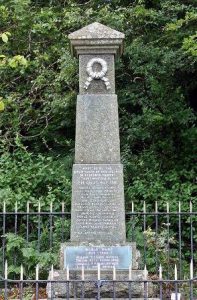
The Great War, 1914-1918
Arthur Leslie Constable, Second Lieutenant, Royal Flying Corps. Arthur was born in Liverpool on 21 April 1891, the son of Alfred Kirby Constable and Rosa Constable. His father died in 1901 and his widowed mother moved to 2, Terrace, Arthog prior to the war. Arthur was commissioned into the Royal Flying Corps on 1 August 1916. He learned to fly at the Military School at Doncaster, and gained his wings on 25 August 1916, flying a Caudron biplane. He joined 43 Squadron, RFC, which had formed at Stirling under the command of Captain William Sholto Douglas, MC, and equipped with Sopwith 1½ strutters before heading to France in January 1917. On 17 March 1917, 43 Squadron was despatched on a photo-reconnaissance mission over Beaumont, escorted by 25 Squadron. Arthur was flying Sopwith A1097, with Second Lieutenant Lownds as his observer, when the Squadron came under attack by Manfred von Richtofen’s ‘Flying Circus’. Arthur’s Sopwith was shot down by Leutnant Kurt Wolff, of Jasta 11, and crashed near Arras, killing both men, whilst another aircraft was shot down by Leutnant Karl Allmenroder. Both were among the most feared German pilots of the Great War. Arthur was 25 years old and is buried near to his observer in Cabaret-Rouge British Cemetery, Souchez, France. Arthur is not commemorated on the Arthog War Memorial.
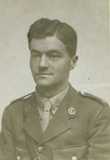
Evan Douglas Davies, Private, 15936, South Wales Borderers. Evan was born at Bryncrug, Towyn in 1895, the son of Evan Jones and Lily Davies. His parents then moved and lived for several years at Quebec Road, Llanbadarn, but by the time of the outbreak of war, were living at Caerinion, Harlech. Evan enlisted at Aberystwyth into the 8th Battalion, South Wales Borderers. The battalion formed at Brecon in 1914, moving to Seaford in 67 Brigade, 22nd Division, and on 6 September 1915 landed at Boulogne. On 30 October 1915 the Division sailed from Marseilles and arrived Salonika about 12 November 1915, where it remained for the rest of the war. Evan had fought with the battalion since its arrival in France, and had fought throughout the campaign in Salonika. He was killed in action there when a shell hit his dugout on 27 July 1918, aged 22, and is buried at Karasouli Military Cemetery, Salonika. His parents later moved to Tyn-y-Coed Gardens, Arthog. Evan is not commemorated on the Arthog War Memorial, but at Harlech and Llanbadarn.
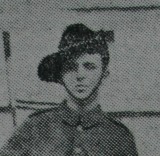
Thomas Donegan, Private, 49924, Cheshire Regiment. Thomas was born on 18 May 1887, the son of Martin Donegan and Ellen Donegan (nee Vaughan), of 31, Hyde Grove, Sale, Cheshire. His father died when he was young, so Thomas was sent to live with his grandfather, Humphrey Vaughan, at Cwmpenllydan, Arthog by 1911 and worked there on the family farm. He enlisted into the 7th Battalion, Cheshire Regiment at Sale on 5 February 1916 and was posted to the Depot at Chester for training. Thomas embarked for France on 24 October 1916, and on 5 November was posted to the 11th Battalion, Cheshire Regiment, which was by then billeted at Meteren, following several months on the Somme. The battalion was attached to 75 Brigade, 25th Division and was preparing for a move into the line near Ploegsteert when Thomas arrived. The division held the line here for the months leading up the Battle of Messines on 7 June 1917, taking part in the great attack on the Messines-Wytschaete Ridge, then the following month moved into the Ypres sector, taking part in the Passchendaele offensive. On 7 August 1917 Thomas was admitted to the 75th Field Ambulance, after falling ill and was treated at the 3rd Canadian Casualty Clearing Station before being sent to the 16th General Hospital at Le Treport to recuperate. Following his recovery he was posted to the 4th Infantry Base Depot at Rouen before rejoining his battalion, which by now had moved out of the Ypres Salient and was in positions around Bullecourt in reserve. On 21 March 1918 the Germans opened up a ferocious artillery barrage along the entire front here before launching the opening phase of their great Spring offensive. Thomas was wounded at sometime after this, suffering a gunshot wound to his left thigh and after being treated at an Advanced Dressing Station was sent to the 47th General Hospital at Le Treport, where he died of his wounds on 12 April 1918. The 31-year-old is buried in Mont Huon Military Cemetery, Le Treport, France. His brother, Martin Joseph Donegan, was also killed during the war.
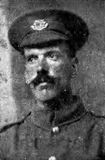
Martin Joseph Donegan, Sergeant, 10649, Cheshire Regiment. Martin was born on 3 January 1890, the son of Martin Donegan and Ellen Donegan (nee Vaughan), of 31, Hyde Grove, Sale, Cheshire. His father died when he was young, so Martin lived for a short while with his grandfather, Humphrey Vaughan, at Cwmpenllydan, Arthog. He then returned home to his mother and found work as a bricklayers labourer prior to the war. Martin enlisted at Altrincham into the Cheshire Regiment soon after the outbreak of war and on 11 January 1915 was drafted to France, joining the 1st Battalion, Cheshire Regiment, which was attached to 15 Brigade, 5th Division. The division had been in France since the outbreak of war and had seen heavy fighting at the Battle of Mons, and during the retreat south, fighting at Le Cateau, and the Marne where the German attack was halted. The division then took part in the advance to the Aisne, before moving to Flanders, where it fought at the Battle of La Bassée, then at Messines in October 1914 as part of the First Battle of Ypres. Martin saw his first major action during the Second Battle of Ypres in April 1915. In March 1916 the Division moved south to positions between St. Laurent-Blangy and Vimy, near Arras, then following the opening of the Somme offensive on 1 July 1916 moved to the Somme to join the great battle, taking part in the bloody fighting at High Wood, Guillemont, Flers-Courcelette, Morval and Le Transloy. Martin must have been invalided at some time, as he was then posted to the 13th Battalion, Cheshire Regiment, which was attached to 74 Brigade, 25th Division. The division was in the line near Ploegsteert when Martin arrived and held this position for the months leading up the Battle of Messines on 7 June 1917, taking part in the great attack on the Messines-Wytschaete Ridge. The 13th Cheshires moved into position on the night of 6 June, and at 03.10 on 7 June, following the blowing of a series of vast underground mines, opened their assault. Martin survived the heavy fighting that day but was killed in action just days later, on 10 June 1917. The 27-year-old is buried in Messines Ridge British Cemetery, Belgium. His brother, Thomas, fought in the same battle, but survived, only to die of wounds the following year. Martin is not commemorated on the Arthog War Memorial.

Ellis Jones Evans, Private, 78135, Royal Army Medical Corps. Ellis was born in 1897, the son of Robert Evans and Jane Evans, of Murneuadd, Arthog. He worked on his parents farm prior to enlisting into the Royal Army Medical Corps at Dolgellau on 4 November 1915 and was posted to the Depot at Aldershot for training. On 23 September 1916 he embarked for France, and remained on the Western Front until taking ill during the autumn of 1917. Ellis was discharged from the army as medically unfit on 8 December 1917, returning home briefly before enlisting into the Mercantile Marine, and was posted aboard the steamship S.S. Grampian, as Quartermaster. His ill-health continued to plague him and Ellis died at sea of peritonitis and cardiac disease on 15 February 1918, aged 20. He is not commemorated as a war casualty by the CWGC, so little else is known of him, but he was presumably buried at sea.
Joseph Lloyd Evans, Private, 37306, Royal Welsh Fusiliers. Joseph was the son of Griffith and Ellen Evans, of 4 Belgrave Road, Fairbourne. He worked as a milkman in London prior to the war. Joseph enlisted into the Royal Welsh Fusiliers in London on 6 December 1915 and was posted to Litherland Camp for training. On 26 April 1916 Joseph embarked at Southampton aboard the SS Copenhagen and landed in Rouen two days later, joining the Infantry Base Depot. He was posted to the 2nd Battalion, Royal Welsh Fusiliers on 7 May 1916 and on 23 June 1916 was slightly wounded by shrapnel whilst the battalion was in the front line at Givenchy. He was back on duty two days later and moved to the Somme with the battalion doon afterwards. The battalion was at the time attached to the 33rd Division, and the Division fought at the Battle of Bazentin Ridge before making an assault on High Wood. Joseph was wounded again at High Wood on 20 July, and was treated at the 4th General Hospital, Rouen, before returning to action on 4 August 1916, joining the 9th Battalion, Royal Welsh Fusiliers, which was attached to 58 Brigade, 19th (Western) Division. The Division was at Pont Remy, resting following its efforts during the earlier stages of the Somme offensive, but on 5 October entrained for Doullens, moving back to the Somme. On 26 October 1916 the Division took over Regina Trench and Hessian Trench, beginning another tour of duty. The 9th Battalion, RWF was in the line on 21 November 1916 when Joseph was killed in action. The 29-year-old has no known grave and is commemorated on the Thiepval Memorial, France. He is also commemorated on memorials at Barmouth and at Llwyngwril.
Daniel Jones, Trumpeter, 2515, Household Battalion. Daniel was the son of Margaret Jones, of Tanllwyn, Arthog. He served as a Policeman in Birkenhead prior to the war. Daniel enlisted into the Household Battalion, which had formed at Knightsbridge Barracks, London on 1 September 1916 as an infantry battalion with personnel from the Household Cavalry Reserve Regiments. On 9 November 1916 the battalion landed in France, joining 10 Brigade, 4th Division. The Division had taken part in heavy fighting during the Somme offensive and in April 1917 took part in the Battle of Arras. The Division saw heavy fighting here for several months and the Household Battalion played its part, losing many men. By 27 August 1917 the battalion had moved into reserve at Stirling Camp. Daniel was sitting alongside one of his comrades, cleaning his rifle, but unfortunately his comrade had a round in the breech, and his gun went off, killing Daniel. His Commanding Officer, Captain Cazalet, wrote a letter to Daniel’s mother explaining the circumstances surrounding his death: ‘August 29, 1917. Dear Mrs. Jones, I expect you will have heard by now of the death of your son serving with this battalion. It was a most dreadfully unfortunate accident, another Trooper was cleaning his rifle and by accident had put a round into the chamber and not knowing that he had done so pulled the trigger and fired the shot, which killed your son instantaneously. I am so very, very, sorry about it, but I assure you it was an absolutely unforeseeable affair, and was an accident as unexpected as it was tragic. He was an excellent fellow and will be missed by his comrades immensely. Please let me know if there is anything else I can tell you, and accept my most sincere sympathy. Yours sincerely, V. A. CAZALET. Captain., P.S. He was buried in the cemetery near here with full burial honours and his grave will be properly tended.’ Daniel was buried in Mindel Trench British Cemetery, St. Laurent-Blangy, France, in an old section of the front line, which ran through the village at the time.
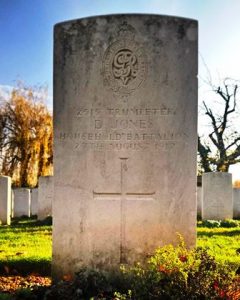
John Jones, Corporal, 2566, Royal Welsh Fusiliers. John was the son of John and Mary Jones, of Pant-y-llan, Arthog. He married Catty Roberts Wynne in 1913, and the couple had one child. Catty resided at The Institute, Aberdovey. John enlisted at Barmouth into the 1/7th Battalion, Royal Welsh Fusiliers. The battalion mobilised at Montgomery on 4 August 1914 as part of North Wales Brigade, Welsh Division. The Division moved to Bedford in May 1915 where it was reorganised, becoming 158 Brigade, 53rd (Welsh) Division, and on 19 July 1915 sailed from Devonport for Imbros, before landing at Suvla Bay on 9 August 1915. The Division advanced inland, but was hindered by a lack of knowledge of the terrain and poor maps, so the advance soon turned into chaos. John was wounded during the first days at Gallipoli, and was evacuated aboard the Hospital Ship Clan McGillivray, where he died of his wounds on 12 August 1915, aged 27. His body was brought ashore and he was buried in Lancashire Landing Cemetery, Gallipoli.
John Lloyd, Corporal, 20188, Royal Welsh Fusiliers. John was the son of Frank and Sarah Ann Lloyd, of 6, Belgrave Road, Fairbourne. He married Alice Batchelor, a domestic servant from Kenilworth, in 1908 and the couple set up home at Railway Cottage, Borth Junction, Arthog, where their two sons were born. John enlisted at Dolgellau into the 14th Battalion, Royal Welsh Fusiliers, which had formed at Llandudno on 2 November 1914, as part of the 43rd (Welsh) Division and he was trained as a sniper. The Division moved to Winchester the following year, becoming the 38th (Welsh) Division, and the 14th RWF formed part of 113 Brigade. John landed in France with the battalion on 2 December 1915, and the entire Division assembled in the Nursery Sector, near Fleurbaix, where it was initiated into trench warfare. The Division then spent time in the Cuinchy sector before marching south to the Somme in June 1916 and from 7 July began its assault on Mametz Wood. Following the capture of the wood, the Division was briefly moved to Hébuterne before taking up positions along the Canal Bank, north of Ypres, where it remained until launching its assault on the Pilckem Ridge on 31 July 1917, during the opening of the Third Battle of Ypres. The attack was a success and on 4 August the 14th RWF was relieved, moving back to Elverdinghe for a rest before moving further back to Proven. It remained in reserve until 22 August when the battalion moved back into the front line near Langemarck. John was killed in action here when a battalion dug-out suffered a direct hit from a German shell on 1 September 1917, aged 33. He is buried in Bard Cottage Cemetery, Belgium. His brother William was killed the following year. Both men are also commemorated on the Llwyngwril War Memorial.
William Lloyd, Gunner, 108449, Royal Field Artillery. William was the son of Frank and Sarah Ann Lloyd, of 6, Belgrave Road, Fairbourne. He enlisted at Dolgellau into the Royal Field Artillery and was posted to France on 21 November 1915, joining the 312th Brigade, Royal Field Artillery, which was attached to the 62nd (West Riding) Division. The Division followed the German Retreat to the Hindenburg Line in March 1917, and then fought at the Battle of Arras. Later that year it took part in the Battle of Cambrai. On 5 January 1918, the Division took over the front line in the Arras area, between Gavrelle and Oppy and saw terrible fighting when it was hit by the German Spring Offensive of 21 March 1918, fighting a rearguard action towards Bucquoy, where it held back attacks by regiments of the Prussian Guard. The battered Division was relieved on 31 March and went into a more peaceful sector to rebuild. Following the Germans third, and last, offensive of 1918, on the Aisne, the Division was among a number sent to re-enforce the beleaguered Divisions there and took part in heavy fighting during the Battle of the Tardenois, where the Division took part in the fighting for the Ardre Valley. The fighting then temporarily died down. William was killed during this relatively quiet time, on 29 July 1918, aged 20. He is buried in Marfaux British Cemetery, France. His brother John had been killed the previous year. Both men are also commemorated on the Llwyngwril War Memorial.
Richard Octavius Newell, Private, 291868, Welsh Regiment. Richard was born in Kerry, Montgomeryshire in 1898, the son of Francis Thomas and Jane Newell. The family later lived at Barmouth Junction, Arthog, where Francis had become Station Master. Richard worked as a Booking Clerk for the Cambrian Railways at Barmouth Station prior to the war, and married Dorothy Alice Davies, of Chirk, in 1917. He had already enlisted into the army, and when he was posted to France joined the 1/6th Battalion, Welsh Regiment, which was the Pioneer battalion to the 1st Division. He probably joined the battalion after the closure of the Passchendaele offensive. The Division was near Éstaires when the second phase of the German Spring Offensive hit on 9 April 1918 and saw heavy fighting during its withdrawal towards Bethune. It was then moved to Arras, and from there took part in the great offensive which was launched on 21 August 1918, seeing action at the Battle of Drocourt-Queant, and at the Battle of Épehy, whilst driving towards the St. Quentin Canal, and then moved towards the Hindenburg Line. Richard was accidentally killed at Berthaucourt, north-west of St. Quentin, on 1 October 1918. The 20-year-old was buried by his comrades in Berthaucourt Communal Cemetery, Pontru, France. He is also commemorated on the Cambrian Railways Memorial at Oswestry.
John Pugh, Private, 202931, Welsh Regiment. John was the son of John and Drusila Pugh, of Brynmeurig, Fairbourne. He lived at Seven Sisters, near Neath prior to the war and enlisted at Neath into the 1/4th Battalion, Welsh Regiment under the name John Pughe, and was posted to France, joining the 17th Battalion, Welsh Regiment, which was attached to 119 Brigade, 40th (Bantam) Division. The Division embarked for France in June 1916, and moved to the front near Loos. Late in 1916 the Division moved south to the Somme, and fought at the Battle of the Ancre, remaining in the area over the winter. In March 1917 the Germans withdrew to their shortened line, called the Hindenburg Line, and the 40th Division was one of the Divisions that followed the withdrawal. Later in the year it took part in the Battle of Cambrai, playing an important role in the attack on Bourlon Wood. They remained in the area over the coming months and on 9 February 1918, following the restructuring of the army, the 17th Welsh was disbanded. John was first posted to the 9th Entrenching Battalion, before being attached to Hood Battalion, 63rd (Royal Naval) Division. On 15 May 1918 the Hood Battalion was in the support line in front of Engelbelmer, on the Somme. The men were busy working on trench improvements, when John was killed by enemy fire. He was 28 years old and is buried in Varennes Military Cemetery, France. He is also commemorated on the war memorials at Bontddu and at Llwyngwril.
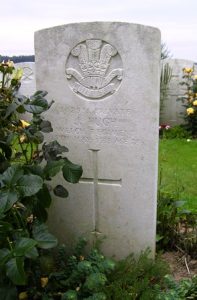
Thomas Roberts, Private, 2850, Royal Welsh Fusiliers. Thomas was the son of Thomas and Emily Roberts, of Tyn Llidiart, Arthog. He enlisted at Dolgellau into the 1/7th Battalion, Royal Welsh Fusiliers. The battalion was a Territorial unit, and assembled for war at Newtown on 4 August 1914, attached to North Wales Brigade, Welsh Division. The battalion moved with the division to Conway until the end of August then to Northampton and by May 1915 was in Bedford, when the formation became 158 Brigade, 53rd (Welsh) Division. On 19 July 1915 the division sailed from Devonport for Imbros and on 9 August 1915 landed at Suvla Bay, Gallipoli. The infantry advanced from the beaches into the bush, but had limited maps and no knowledge of the terrain, so as a result, the landings soon turned into chaos. Thomas was killed in action on the second day, 10 August 1915, aged 22. He has no known grave and is commemorated on the Helles Memorial, Gallipoli. He is also commemorated on the Dolgellau War Memorial.
Arthur Edward Whittall, Sergeant, 367, Lancashire Fusiliers. Arthur was the son of Richard and Mary Whittall, of Beach Road, Fairbourne. He was working as a joiner at Salford by 1911, and married Annie Buxton, at Christ Church, Salford, on 12 August 1911. He was a pre-war member of the 1/7th Battalion, Royal Welsh Fusiliers. The battalion was a Territorial unit, and assembled for war at Newtown on 4 August 1914, attached to North Wales Brigade, Welsh Division. The battalion moved with the division to Conway until the end of August then to Northampton and by May 1915 was in Bedford, when the formation became 158 Brigade, 53rd (Welsh) Division. On 19 July 1915 the division sailed from Devonport for Imbros and on 9 August 1915 landed at Suvla Bay, Gallipoli. The infantry advanced from the beaches into the bush, but had limited maps and no knowledge of the terrain, so as a result, the landings soon turned into chaos. Arthur was wounded at Gallipoli and was evacuated by Hospital Ship to Malta, where he remained for three months, before returning to England and was taken to the Manchester Infirmary. Arthur finally died as a result of his wounds with his wife Annie by his side, on 6 March 1916, aged 29. He was buried with full military honours in Weaste Cemetery, Salford. Arthur is also commemorated on the Llwyngwril War Memorial.
Elias Robert Williams, Private, 291464, Royal Welsh Fusiliers. Elias was born at Corris, the son of John and Sarah Ann Williams. By 1901 the family was living at Murneuadd, Arthog. Elias became a schoolteacher at Barmouth Council School, then by 1911 was teaching at Blaenau Ffestiniog. At the outbreak of war he was teaching at Rhyl Council School. He enlisted at Rhyl into the Royal Welsh Fusiliers on 7 December 1915. He was mobilised on 10 February 1916 and joined the 3/7th Battalion, Royal Welsh Fusiliers at Oswestry. On 3 July 1916 he was posted to Egypt, joining the 1/7th Battalion, Royal Welsh Fusiliers, which was attached to 158 Brigade, 53rd (Welsh) Division. The division had moved to Egypt following service in Gallipoli, to join the EEF, and helped clear the Turks out of Sinai, safeguarding the Suez Canal, before beginning the campaign to capture Palestine in 1917. The division took part in two unsuccessful attacks on Gaza in March and April 1917, before the EEF was re-organised and on the night of 1 November 1917 launched the Third Battle of Gaza. This third assault was a success, which saw Gaza captured and the road to Jerusalem now lay wide open. Elias was wounded during the battle and was evacuated to the hospital in Kantara, where he died of his wounds on 11 November 1917, aged 28. He is buried in Kantara War Memorial Cemetery, Egypt. Elias is also commemorated on the war memorials at Rhyl and Barmouth.
Morris Williams, Private, 6253, Royal Welsh Fusiliers. Morris was the son of Anne Williams, of Arthog. He had left home at the age of 17 to enlist into the south Wales Borderers on 11 December 1894. Upon leaving the army he became a collier in the South Wales valleys. He re-enlisted at Cardiff into the 3rd Battalion, Royal Welsh Fusiliers on 29 September 1914 and on 11 November 1914 embarked for France, joining the 1st Battalion, Royal Welsh Fusiliers, which was attached to 22 Brigade, 7th Division. The battalion was in billets at Merris when Morris arrived, and was enjoying a rest before moving to the front line at Bois-Grenier. The battalion suffered a torrid spell in the trenches over the coming weeks and by the beginning of March 1915 had moved to a new position near the town of Neuve Chapelle, to take part in a forthcoming offensive there. Morris was killed in action here on 9 March 1915, aged 37, the day before the launching of the battle. He has no known grave and is commemorated on the Le Touret Memorial, Richebourg-L’avoue, France.
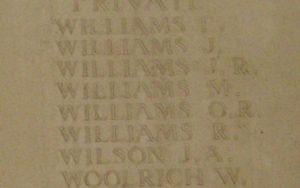
World War Two, 1939-1945
Charles De Cardonnel Findlay, Pilot Officer, 122485, Royal Air Force Volunteer Reserve. Charles was the son of Captain Victor Alexander Charles Findlay and Joan Gilbert Findlay (nee Casson), who were married on 21 July 1920, at Simla, Bengal, India. Charles was born in London in 1921. His parents divorced a couple of years after his birth, and his mother remarried Adam Duncan Chetwynd, 9th Viscount Chetwynd of Bearhaven Co. Cork, Ireland, on 28 April 1928. The family had a home at Tynycoed Mansion, Arthog. Charles enlisted into the Royal Air Force and trained as a pilot before being posted to Canada. On 28 August 1942 Charles was flying to Northern Ireland from Newfoundland aboard a Lockheed Ventura IIa, Serial AE917, of Ferry Command. The aircraft suffered problems and sent out an SOS before crashing into the sea off Ireland that day, killing all four men aboard. Two of the crewmens bodies later washed ashore in Galway and were afforded proper burials, but Charles and Sergeant Rhys Alexander were never seen again. Charles was 21 years old when he died that day and is commemorated on the Ottawa Memorial, Canada.
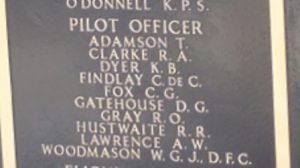
William Thomas Lewis, Serjeant, 4191887, Royal Welch Fusiliers. William was the nephew and adopted son of William and Susie Thomas, of Arthog. He enlisted into the 7th Battalion, Royal Welch Fusiliers, which was attached to 158 Brigade, 53rd (Welsh) Division. The division was a Territorial one and spent most of the war on home service, initially in Northern Ireland, before being transferred to the south of England. On 25 June 1944 the division landed in Normandy, in order to take part with the break-out from the Normandy beach-head and over the coming weeks saw heavy fighting, especially during the Battle for Caen and the fierce fighting in the Bocage. At 13.00 on 11 August 1944 the 7th RWF received orders for an attack on the village of Fresney-le-Vieux and the battalion began to move up to a concentration area North of Les Moutiers-en-Cinglis. The advance troops came under fire from Germans in the village, and fighting ensued in the orchards surrounding the village. William was killed in action here during the fighting that day. He was 29 years old and is buried in Brouay War Cemetery, Normandy.
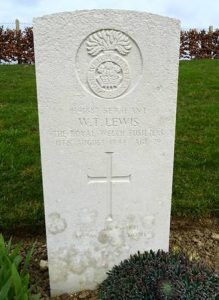
John Llewelyn Rees, Flight Lieutenant, 39158, Royal Air Force. John was born on 7 May 1911, the son of the Reverend Nathaniel Rees and Mrs. Rees, of The Vicarage, Arthog. He lived at Rosehill, Aberdyfi prior to training as a pilot, and gained his Royal Aero Club Pilot’s Certificate at the Cardiff Aeroplane Club on 4 July 1934. He married physiotherapist and fellow pilot Helen Christina Easson Evans in London in 1939. John had been commissioned into the Royal Air Force in 1936, training at 11 Flying Training School. By 1940, John was based at 15 OTU, at RAF Harwell. On 5 August 1940 he took off from Harwell aboard a Vickers Wellington I, Serial L4264, on a training flight around the aerodrome, but the aircraft stalled whilst turning and crashed into a nearby field, Killing John and two other men, Pilot Officer Lester and Pilot Officer Arup. John’s remains were brought home for burial by his father at St. Catherine’s Churchyard, Arthog. He is also commemorated on the Aberdyfi War Memorial.
Trevor Lewis Rees, Able Seaman, D/JX 229994, Royal Navy. Trevor was born on 14 May 1921, the son of Edward and Mary Jane Rees, of Bodlondeb, Fairbourne. He enlisted into the Royal Navy and was posted to HMS President III for training, before being posted aboard the Yugoslavian Merchant Vessel MV Nikolina Matkovik. On 13 October 1942, she was en-route from Ciudad Trujillo, Dominican Republic to Liverpool, with Convoy SC-104, carrying a cargo of sugar and timber, when she was torpedoed and sunk by the German U-Boat U-661. Most of the crew managed to cling onto rafts, but Trevor and 13 other men were lost. He was 21 years old when he died that day and is commemorated on the Plymouth Naval Memorial, Devon.